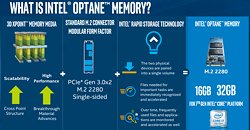- Joined
- Oct 9, 2007
- Messages
- 47,527 (7.48/day)
- Location
- Hyderabad, India
| System Name | RBMK-1000 |
|---|---|
| Processor | AMD Ryzen 7 5700G |
| Motherboard | ASUS ROG Strix B450-E Gaming |
| Cooling | DeepCool Gammax L240 V2 |
| Memory | 2x 8GB G.Skill Sniper X |
| Video Card(s) | Palit GeForce RTX 2080 SUPER GameRock |
| Storage | Western Digital Black NVMe 512GB |
| Display(s) | BenQ 1440p 60 Hz 27-inch |
| Case | Corsair Carbide 100R |
| Audio Device(s) | ASUS SupremeFX S1220A |
| Power Supply | Cooler Master MWE Gold 650W |
| Mouse | ASUS ROG Strix Impact |
| Keyboard | Gamdias Hermes E2 |
| Software | Windows 11 Pro |
Intel's first consumer (client) SSD based on its revolutionary new 3D Xpoint memory is an Optane branded cache SSD that improves the performance of slower local storage, such as hard drives, or even slower NAND flash based SSDs. On machines with larger hard drives, Intel claims that a 3D Xpoint based cache SSD could halve booting times, improve overall system performance by 28 percent, and lower game level load times by up to 65 percent. As a cache-SSD, it's also designed to be affordable, and that's because it's local storage is 16 GB or 32 GB.
The target consumer is one that which is transitioning from hard drives to SSDs, and is happy with a noticeable performance boost, as long as they don't lose the immense capacities of their HDDs. It also targets gamers with SSDs that are running out of space for multiple >50 GB games, so they could start installing some of those games on their larger/slower HDDs and get reasonably improved performance. As with all SSD caching technologies from Intel in the past, such as the ReadyBoost and Smart Response, Optane cache SSDs juggle "hot data" (frequently accessed data) in and out of their user-space from the host storage. On the software side of things, Intel Rapid Storage Technology 15.5 and later handles the caching tasks.

The Optane cache SSD is a single-sided M.2-2280 drive with PCI-Express 3.0 x2 host interface, and takes advantage of the NVMe protocol. The drives offer sequential speeds of up to 1200 MB/s reads, with up to 280 MB/s writes, and 4K random access performance of up to 300,000 IOPS reads, with up to 70,000 IOPS writes. What Optane brings to the table is a gargantuan command queue depth, and an endurance rating of 100 GB writes per day (which is huge for a 16 or 32 GB drive, given that it's over 6 DWPD for the 16 GB variant.



View at TechPowerUp Main Site
The target consumer is one that which is transitioning from hard drives to SSDs, and is happy with a noticeable performance boost, as long as they don't lose the immense capacities of their HDDs. It also targets gamers with SSDs that are running out of space for multiple >50 GB games, so they could start installing some of those games on their larger/slower HDDs and get reasonably improved performance. As with all SSD caching technologies from Intel in the past, such as the ReadyBoost and Smart Response, Optane cache SSDs juggle "hot data" (frequently accessed data) in and out of their user-space from the host storage. On the software side of things, Intel Rapid Storage Technology 15.5 and later handles the caching tasks.

The Optane cache SSD is a single-sided M.2-2280 drive with PCI-Express 3.0 x2 host interface, and takes advantage of the NVMe protocol. The drives offer sequential speeds of up to 1200 MB/s reads, with up to 280 MB/s writes, and 4K random access performance of up to 300,000 IOPS reads, with up to 70,000 IOPS writes. What Optane brings to the table is a gargantuan command queue depth, and an endurance rating of 100 GB writes per day (which is huge for a 16 or 32 GB drive, given that it's over 6 DWPD for the 16 GB variant.



View at TechPowerUp Main Site
Last edited:







